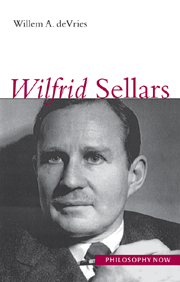Book contents
- Frontmatter
- Contents
- Preface
- Abbreviations
- 1 Sellars's philosophical enterprise
- 2 Sellars's philosophy of language
- 3 Categories, the a priori, and transcendental philosophy
- 4 Sellars's nominalism
- 5 Knowledge and the given
- 6 Science and reality
- 7 Intentionality and the mental
- 8 Sensory consciousness
- 9 Practical reason
- 10 The necessity of the normative
- Notes
- Bibliography
- Index
10 - The necessity of the normative
- Frontmatter
- Contents
- Preface
- Abbreviations
- 1 Sellars's philosophical enterprise
- 2 Sellars's philosophy of language
- 3 Categories, the a priori, and transcendental philosophy
- 4 Sellars's nominalism
- 5 Knowledge and the given
- 6 Science and reality
- 7 Intentionality and the mental
- 8 Sensory consciousness
- 9 Practical reason
- 10 The necessity of the normative
- Notes
- Bibliography
- Index
Summary
Real and ideal, empirical and transcendental
Sellars often characterized his project as a Kantian response to the dominant empiricism of his day. The comparison with Kant is illuminating, but it can also be a trap, masking some important features of Sellars's philosophy. It invites one to assimilate Sellars's distinction between the manifest and scientific images to Kant's distinction between the phenomenal and noumenal realms, for instance, which Sellars himself at times encourages. While there is something to the analogy, it requires a commentary. The most obvious disanalogy between the manifest–scientific image distinction and Kant's phenomenal–noumenal distinction is that Kant's noumenal realm is in principle beyond our ken. As a latter-day Critical Realist, Sellars rejects the idea that reality is in principle beyond our knowledge. In Sellars's view, the dogged pursuit of science is in principle capable of revealing reality as it is in itself. Achieving knowledge of the intrinsic nature of things may well be indefinitely far off in a Peircean culmination of enquiry, but the scientific image is not an unknowable noumenon. The world targeted by the scientific and the manifest images is one and the same, even if the particular objects in the scientific image and the manifest image differ significantly.
For Sellars, both the manifest framework and the scientific framework are transcendentally ideal and empirically real, although, again, we need commentary to keep these claims from being terribly misleading.
- Type
- Chapter
- Information
- Wilfrid Sellars , pp. 269 - 282Publisher: Acumen PublishingPrint publication year: 2005



